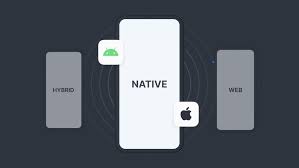
I. Introduction
In the grand theater of technology, smartphones emerge as true gems of the digital revolution. They have awakened our world to a realm of unimaginable opportunities and connectivity, radically transforming the way we live and work.
Today, we invite you to dive into this fascinating technological odyssey: the evolution of mobile development, from its humble roots to its brilliant present. It's an exciting exploration that unveils the foundations of this ever-changing world and the incredible advances that have shaped our daily lives.
Get ready to time-travel through the epochs of mobile development, where each step in this story reveals a crucial chapter of our digital adventure.
II. The Early Mobile Beginnings

2.1. The Initial Explosion: Pioneering Mobile Phones and Developments
Transport yourself to the 1980s, an era when wireless communication dreams were just starting to take shape. Mobile phones were then bulky prototypes, far from the sleek devices we know today. These technological "bricks," weighing several kilos, were the precursors to revolutions to come.
The early steps of mobile development were the result of the relentless efforts of researchers and technology pioneers. They had to overcome enormous technological challenges, such as miniaturizing electronic components and creating functional wireless networks. These innovations paved the way for the first generation of mobile phones, enabling mobile calls and sparking a global craze.
2.2. The Birth of Mobile Applications: From Rudimentary Experiences to Early Excitement
The beginnings of mobile applications were modest but promising. Picture yourself navigating a rudimentary interface with simple text lines and characters. The first mobile applications were basic tools: calendars, contact lists, and perhaps a highly simplified Pong game.
Developers at that time were dedicated to creating interactive experiences even with significant technological constraints. They juggled with low processing power and memory limitations while striving to offer useful features to users.
Tips for Today's Developers:
- Historical Knowledge: Understanding the challenges faced by mobile development pioneers can inspire modern developers to overcome current obstacles.
- Performance Optimization: Even with hardware limitations, applications were designed to run smoothly. It's crucial to optimize application performance, regardless of the current power of smartphones.
- Focus on Essentials: Early applications focused on basic features. Prioritizing essential features and evolving from there, always keeping user utility in mind, remains important.
III. The Golden Age of Native Applications

3.1. The Smartphone Revolution: When Mobiles Become Pocket Computers
Let's delve into the 2000s, an era that witnessed a monumental transformation. Mobile phones evolved beyond their simple communication function to become true pocket computers.
The advent of smartphones brought computing power comparable to personal computers, now fitting in the palms of our hands. Smartphones were mini-computers, and their operating system was the key. Platforms like iOS and Android paved the way for more advanced and specialized applications, allowing users to customize their experiences according to their needs and preferences.
3.2. Magic of Native Applications: Immersing in Interactive Worlds on iOS and Android
Mobile web-based applications are accessible via a mobile browser, offering portability and multi-platform access.
Here's an in-depth overview and essential tips for a better understanding of web-based mobile application development:
Advantages of Web-Based Applications:
- Portability and Accessibility: Being accessible via a browser, these applications offer exceptional portability, allowing users to use them on any device with a mobile browser.
- Storage Efficiency: Since these applications don't need to be installed on the phone, they don't take up valuable storage space on the user's device.
- Instant Updates: Updates and fixes are immediately available to all users as soon as they access the application via the browser, eliminating delays associated with manual app updates.
- Ease of Development and Maintenance: With a single codebase, development is streamlined, and maintenance is less complex, as updates apply instantly to all users.
Tips for Successful Web-Based Development:
- Performance Optimization: Ensure the application provides a smooth experience by optimizing loading and minimizing response times. This can be achieved by optimizing images, using CDNs for content delivery, and minimizing network requests.
- Enhanced Security: Incorporate robust security measures to protect user-sensitive data, as web applications are often exposed to security risks. Use HTTPS, encode data, and implement mechanisms to guard against common attacks like SQL injections and XSS attacks.
- Responsive Design and Adaptability: Design a responsive and adaptive user interface that adjusts seamlessly to various screen sizes, ensuring an optimal user experience on all devices, from smartphones to tablets.
- Cache Management: Use cache storage to reduce loading times by locally storing frequently used resources. This will significantly improve the application's speed.
Web-based mobile applications are an excellent option for projects requiring rapid visibility and multi-platform compatibility without sacrificing user experience quality. By choosing this path, optimize the application for performance, security, and adaptability, ensuring an optimal user experience.
IV. The Hybrid Development Blend

Hybrid development rests on a simple yet powerful idea: using a single codebase to create mobile applications that work on different platforms. By merging web technologies (HTML, CSS, JavaScript) and leveraging native development benefits, hybrid development offers significant gains in terms of cost, development speed, and maintenance.
Advantages of Hybrid Development:
- Time and Cost Savings: Hybrid development significantly reduces development time and costs by avoiding separate coding for each platform.
- Ease of Maintenance: With a single codebase, updates and fixes can be applied uniformly across all platforms.
- Access to Device Features: Modern hybrid frameworks provide full access to device features, offering a user experience close to native.
The Dance of Frameworks: React Native, Xamarin, and Flutter, Modern Companions
Frameworks play a crucial role in the hybrid development ecosystem. Here are three major players making waves in this technological dance:
- React Native: Based on JavaScript and React, it offers high performance and great responsiveness. It is ideal for rapid development and prototyping.
- Xamarin: Owned by Microsoft, Xamarin uses the C# language and .NET. It ensures a user experience similar to native and excellent integration with Microsoft products.
- Flutter: Powered by Google and using the Dart language, Flutter is known for its rapid design and high performance. Its "compile to machine code" approach provides excellent responsiveness.
Tips for Choosing a Hybrid Framework:
- Evaluate Performance: Test the application's performance on different platforms and under various conditions. Choose the framework that provides a smooth and fast user experience.
- Consider Community and Documentation: An active community and comprehensive documentation can be your best allies. Ensure that the framework has a strong developer base for continuous support and updates.
- Analyze Required Features: Make sure the chosen framework offers all the necessary features for your application. Some frameworks may better address specific needs.
- Test on Real Devices: Test your application on various devices to ensure compatibility and real performance.
V. The Dream of Cross-Platform Development

5.1. The Era of Versatility: Challenges of Multiple Platforms
With users spread across iOS, Android, and other operating systems, creating an application that runs smoothly and consistently on all these platforms has become a necessity.
Modern consumers demand a consistent and intuitive user experience, whether they use an iPhone or an Android smartphone. This is where cross-platform development shines, allowing developers to create high-performing and uniform applications, regardless of the platform.
5.2. Flutter, React Native, and Many More: Embracing Diversity and Consistency
In this diverse world of mobile platforms, certain frameworks stand out for their ability to fulfill the dream of cross-platform development. Two of them have gained great popularity:
- Flutter: Designed by Google and based on the Dart language, Flutter offers an innovative paradigm. It enables the creation of aesthetically pleasing and fluid user interfaces while sharing a single codebase between iOS and Android.
- React Native: Originating from Facebook, React Native is based on JavaScript. It is a preferred choice for its rapid development and responsiveness. Through the reuse of native components, it provides a user experience close to native.
5.3 Tips for Embracing Cross-Platform Diversity
- Thorough Analysis of Specific Needs: Understand the precise requirements of your application. Some projects may benefit more from pure performance, while others may emphasize an attractive user interface.
- Mastery of Each Framework's Specifics: Explore in detail the advantages, disadvantages, and unique features of each framework. Prototype to assess their fit with your project.
- Optimization for Each Platform: Although cross-platform development aims for reuse, it is essential to optimize the interface for each platform. Ensure that the application seamlessly integrates into the visual environment of each OS.
- Comprehensive Testing on Real Devices: Test your application on various devices, both on iOS and Android. Verify that the application works seamlessly and smoothly on all devices.
- Implementation of Best Practices: Adhere to the best practices of development for each framework. This ensures that your code is clean, maintainable, and scalable.
VI. The Art of Seduction through User Experience (UX)
6.1 The Soul of Applications: How UX Transforms a Simple App into a Memorable Experience
User experience (UX) is much more than a mere aesthetic addition to an application. It is the soul that animates every interaction, every visual element, every line of code. UX is the art of creating a meaningful and memorable experience for every user entering the application's universe.
Imagine UX as a captivating story. Each design element, each transition, each interaction is an integral part of this story. Every movement should be deliberate, every detail should have a purpose. UX transforms mere usage into a sensory experience that resonates in the user's heart.
6.2 The Puzzle of Success: Deciphering the Secrets of Charming and Retaining UX
Behind every successful application lies an exciting puzzle: how to create a user experience that charms and retains? Here are some secrets to help you solve this puzzle and create a captivating UX:
Secrets of a Captivating UX:
- User Research and Analysis: Before even touching design, understand your users. Conduct research, create personas, and analyze their needs, behaviors, and expectations.
- Storytelling through Design: Use design to tell a smooth story to the user. Each interaction should be a step in this narrative, guiding the user through their journey.
- User Feedback and Iterations: Test your design with real users, gather their feedback, and iterate. UX is a continuous process of improvement based on feedback and data.
- Simplicity and Utility: Provide a simple and intuitive interface. Every element should serve a purpose. Eliminate anything that does not contribute to the experience.
- Performance Optimization: UX is greatly affected by the application's performance. Ensure that the application responds quickly and operates seamlessly.
6.3 Tips for Creating an Unforgettable UX
- Rapid Prototyping: Create prototypes quickly to validate design ideas early on and save time.
- Collaboration and Feedback: Encourage close collaboration between design, development, and product management teams. Mutual feedback stimulates creativity and continuous improvement.
- User Testing Sessions: Regularly organize user testing sessions to get direct feedback on the experience offered by your application.
- Usage Data Analysis: Use analytics tools to track user behavior in the application. Identify the most frequent points of interaction and potential issues.
VII. The Infinite Horizons of Mobile Development
7.1 The Era of Artificial Intelligence: When Our Apps Become Smarter
Dive into an exciting era where artificial intelligence (AI) revolutionizes mobile development. AI transforms our applications into intelligent entities capable of learning, adapting, and anticipating user needs.
The benefits of AI in mobile development include personalized user experiences, automation of repetitive tasks, content recommendations, and much more. Developers should explore frameworks such as TensorFlow, PyTorch, and scikit-learn to effectively integrate AI into their applications.
7.2 The Digital Shield: Priority on Security in Mobile Development
In today's mobile ecosystem, security is crucial to gaining user trust. The digital shield represents a proactive approach to anticipate and counter potential threats. This involves the use of encryption, two-factor authentication, firewalls, and raising user awareness to adopt security practices.
To ensure optimal security in mobile development, development teams must follow security standards, conduct penetration testing, and regularly update software to address vulnerabilities.
7.3 Speed of Light: How 5G Shapes the Future of Mobile Development and Features
5G represents a revolution in the world of mobile connectivity, offering ultra-fast speeds, minimal latency, and massive connection capacity. For developers, this opens up new perspectives for mobile applications
Features such as real-time augmented reality, high-definition streaming, latency-free multiplayer gaming, are now conceivable thanks to 5G. Developers must optimize their applications for this technology by reducing data consumption and creating reactive and rich experiences.
7.4 Tips for Exploiting the Infinite Horizons of Mobile Development
- Continuous AI Training: Developers must attend training and courses to stay updated on the latest advances in AI and effectively integrate them into their applications.
- Regular Security Audits: Plan regular security audits to identify and rectify potential security vulnerabilities in the application.
- Optimization for 5G: When designing new features, consider how they could benefit from 5G and ensure that the application is ready to leverage this technology.
- Collaboration and Knowledge Sharing: Encourage a culture of collaboration within the development team to exchange knowledge and experiences, fostering creativity and innovation.
Conclusion
An Epic Journey through the Evolution of Mobile Development
We have embarked on a fascinating journey through the twists and turns of mobile development evolution. From its humble beginnings to its transformation into a flourishing technological universe, this journey has revealed the power of innovation and the rapid progress of technology.
The Call for Continuous Exploration: The Ever-Changing World of Mobile Development
However, our journey is not over. On the contrary, it is the beginning of an infinite adventure. The future of mobile development is promising, offering a blank canvas for the creators of tomorrow. We are called to embrace this constant evolution, to explore the unknown with boldness and curiosity.
The Invitation to Stay on the Front Lines: Become a Hero in this Ever-Evolving Saga
The mobile development industry is a saga in perpetual motion. To stay relevant and thrive in this dynamic ecosystem, we are invited to remain on the front lines. This means being attentive to the latest trends, emerging innovations, and disruptive technologies.
Every developer, designer, and innovator is a potential hero in this grand epic. Our role is to continue creating, pushing boundaries, and shaping the future of mobile development. So, let this conclusion be just the beginning of your own saga in this thrilling and ever-evolving world.


